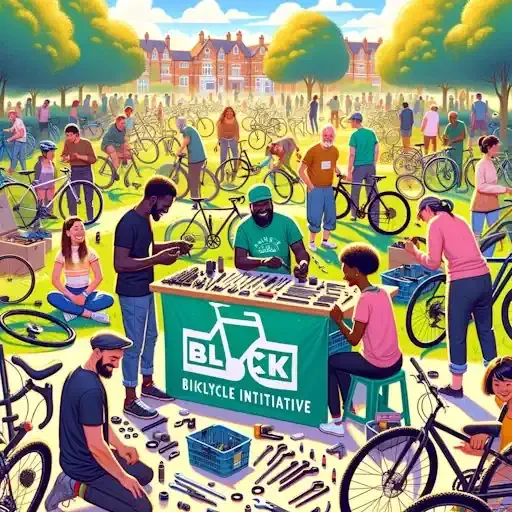Introduction
In the bustling streets of cities worldwide, a ubiquitous sight emerges amidst the chaos of urban life – the black bicycle. It is more than just a mode of transportation; it is a symbol of freedom, efficiency, and cultural significance. From its humble origins to its current status as an urban staple, the black bicycle has traversed through history, leaving an indelible mark on society.
This article embarks on a journey to explore the multifaceted legacy and evolution of the black bicycle. Beyond its utilitarian purpose, we delve into its rich cultural symbolism, its role in shaping urban landscapes, and its contributions to social justice, environmental sustainability, and technological innovation. From literature to city planning, from grassroots advocacy to global trends, the black bicycle embodies a multitude of narratives and perspectives.
As we embark on this exploration, we invite you to join us in unraveling the layers of meaning behind the black bicycle, understanding its past, present, and future implications. Through this journey, we aim to shed light on the enduring significance of this iconic two-wheeled companion and its profound impact on the way we live, move, and connect in the modern world.
ANCHEER Folding Electric Bike, 20MPH, 45 Miles, Foldable
The perfect companion for urban commuters and adventure seekers with its lightweight and foldable design - ANCHEER Folding Electric Bike, 20MPH, 45 Miles, Foldable
Product information
$289.99
Product Review Score
4.22 out of 5 stars
105 reviewsProduct links
Historical Context
The origins of the black bicycle can be traced back to the late 19th century, coinciding with the dawn of the cycling craze that swept across Europe and North America. As innovations in manufacturing and engineering made bicycles more accessible and affordable, they quickly became a symbol of progress and modernity.
During this period, bicycles were predominantly crafted from steel, a material that lent itself well to the classic black frame that would become synonymous with the vehicle. The black bicycle emerged not only as a practical means of transportation but also as a cultural icon, embodying the spirit of adventure and independence.
One pivotal moment in the history of the black bicycle was the introduction of the safety bicycle in the 1880s, which featured a diamond-shaped frame and pneumatic tires. This revolutionary design made cycling safer and more comfortable, leading to a surge in popularity among both men and women from diverse socioeconomic backgrounds.
Throughout the late 19th and early 20th centuries, the black bicycle became a fixture in popular culture, depicted in literature, art, and advertising. It symbolized mobility, progress, and freedom, reflecting the aspirations of a rapidly changing society.
During World War II, bicycles played a crucial role in transportation, providing a reliable means of getting around amidst fuel shortages and rationing. The black bicycle, with its simple yet durable design, became a lifeline for many communities, facilitating essential tasks such as commuting to work, delivering goods, and maintaining social connections.
In the post-war era, as cities expanded and automobile culture proliferated, the black bicycle experienced a decline in popularity in some regions. However, it persisted as a mode of transportation in urban areas where space was limited, traffic congestion was high, and environmental concerns began to take center stage.
Today, the legacy of the black bicycle lives on, as cities worldwide embrace cycling as a sustainable and efficient mode of transportation. From its humble beginnings to its enduring presence in contemporary society, the black bicycle continues to symbolize the timeless values of freedom, mobility, and progress.
Cultural Significance
The black bicycle holds a profound cultural significance that transcends its practical function as a mode of transportation. Across literature, art, film, music, and fashion, it has become a symbol imbued with diverse meanings and interpretations, reflecting the values and aspirations of different societies and subcultures.
In literature, the black bicycle often serves as a metaphor for freedom, exploration, and self-discovery. Writers have used it to evoke a sense of escape from the constraints of society or to symbolize the journey towards personal liberation. From Jack Kerouac's beat generation classic "On the Road" to Haruki Murakami's contemporary novels, the black bicycle has featured prominently as a motif of wanderlust and adventure.
Similarly, in art and film, the black bicycle has been depicted in various contexts, ranging from romanticized portrayals of carefree cyclists exploring picturesque landscapes to gritty urban scenes of cyclists navigating bustling city streets. Artists and filmmakers have leveraged the visual imagery of the black bicycle to evoke themes of nostalgia, rebellion, and resilience, capturing the essence of contemporary life.
In music, the black bicycle has inspired songs across genres, from folk and rock to hip-hop and electronic music. Whether as a symbol of youthful rebellion, environmental consciousness, or urban cool, the black bicycle has found its way into lyrics and album artwork, resonating with audiences around the world.
Moreover, the black bicycle has left its mark on fashion, influencing trends in both clothing and accessories. From vintage-inspired cycling caps and messenger bags to sleek urban cycling apparel, designers have embraced the aesthetic of the black bicycle, blending form and function to create stylish yet practical garments for cyclists and enthusiasts alike.
Beyond its representation in culture and the arts, the black bicycle has also played a significant role in shaping subcultures and countercultural movements. From the early days of the cycling craze to the rise of bike messenger culture and fixed-gear bike communities, cyclists have formed tight-knit communities centered around their shared passion for riding.
In essence, the cultural significance of the black bicycle lies in its ability to transcend boundaries and resonate with people from all walks of life. As a symbol of freedom, mobility, and self-expression, it continues to inspire and captivate, leaving an indelible mark on the cultural landscape of the modern world.
Urban Mobility
The black bicycle has become an integral part of urban mobility, offering a sustainable, efficient, and affordable means of transportation in increasingly congested city environments. Its popularity in urban areas can be attributed to several factors, including its versatility, accessibility, and positive impact on both individuals and communities.
The Rise of the Black Bicycle in Urban Environments:
Growing urbanization trends: With more people living and working in cities, the demand for alternative transportation modes has increased, leading to a resurgence in cycling.
Infrastructure improvements: Cities around the world have invested in cycling infrastructure, including bike lanes, bike-sharing programs, and bike-friendly policies, making cycling safer and more accessible.
Changing attitudes towards sustainability: As awareness of environmental issues grows, many urban dwellers are choosing to cycle as a greener alternative to driving or using public transport.
Impact on Transportation and City Planning:
Alleviating traffic congestion: By reducing the number of cars on the road, cycling helps alleviate traffic congestion, leading to smoother traffic flow and shorter commute times for all road users.
Improving air quality: Cycling produces zero emissions, making it a clean and environmentally friendly mode of transportation that contributes to improved air quality in urban areas.
Enhancing public health: Regular cycling has been linked to numerous health benefits, including reduced risk of chronic diseases, improved mental well-being, and increased physical fitness, leading to healthier and more active urban populations.
Influencing urban design: The presence of cyclists in cities has prompted urban planners to reconsider the design of streets and public spaces, prioritizing the needs of pedestrians and cyclists over those of motor vehicles.
Advantages and Challenges of Biking in the City:
Advantages:
Flexibility and convenience: Bicycles offer greater flexibility than public transport and can often provide door-to-door service, allowing cyclists to navigate urban environments with ease.
Cost-effectiveness: Cycling is significantly cheaper than owning and maintaining a car or relying on public transport, making it an attractive option for budget-conscious urban dwellers.
Health and well-being: Cycling provides an opportunity for physical exercise and outdoor recreation, contributing to improved mental and physical well-being.
Challenges:
Safety concerns: Despite improvements in infrastructure, cyclists still face risks such as accidents, collisions, and theft, particularly in cities with inadequate cycling infrastructure and aggressive traffic.
Weather conditions: Inclement weather, such as rain, snow, or extreme heat, can pose challenges for cyclists, making cycling less appealing or feasible during certain times of the year.
Limited infrastructure: In some cities, cycling infrastructure remains inadequate, with insufficient bike lanes, poorly maintained roads, and inadequate facilities for parking and storage, hindering the widespread adoption of cycling as a mode of transportation.
The black bicycle has emerged as a vital component of urban mobility, offering a sustainable, efficient, and healthy alternative to traditional modes of transportation in increasingly congested city environments. While challenges remain, the continued investment in cycling infrastructure and promotion of cycling culture hold the promise of creating more livable, sustainable, and equitable cities for all.
Social Justice and Equity
The black bicycle plays a crucial role in addressing issues of social justice and equity, particularly in marginalized communities where access to reliable transportation can be limited. By providing an affordable, accessible, and environmentally friendly mode of transportation, cycling initiatives empower individuals and communities, fostering greater mobility, independence, and opportunity.
Access to Black Bicycles in Marginalized Communities:
Transportation inequality: In many urban areas, marginalized communities, including low-income neighborhoods and communities of color, face disproportionate barriers to accessing affordable and reliable transportation options, such as public transit or private vehicles.
Cycling as a solution: Cycling offers a viable solution to transportation inequality, providing individuals in marginalized communities with a means of getting to work, school, healthcare facilities, and other essential destinations, regardless of their socioeconomic status or geographic location.
Community-based initiatives: Organizations and grassroots groups are working to increase access to black bicycles in marginalized communities through initiatives such as bike libraries, community bike shops, and bicycle donation programs, ensuring that everyone has the opportunity to experience the benefits of cycling.
Initiatives Promoting Cycling as a Means of Empowerment:
Empowering individuals: Cycling empowers individuals by giving them greater control over their mobility and reducing dependence on unreliable or inaccessible transportation options.
Building community resilience: Cycling fosters community resilience by creating networks of support and mutual aid, strengthening social ties and promoting a sense of belonging and solidarity among residents.
Promoting economic opportunities: Cycling can create economic opportunities for individuals in marginalized communities, such as employment as bicycle mechanics, delivery riders, or tour guides, while also supporting local businesses and economies.
Addressing Inequalities in Bike Infrastructure and Policies:
Equitable infrastructure development: To ensure that cycling is accessible to all, cities must prioritize the development of bike infrastructure in marginalized communities, including the construction of bike lanes, bike parking facilities, and safe routes to schools and other essential destinations.
Advocating for inclusive policies: Advocacy groups and community organizations are working to advocate for policies that promote equitable access to cycling, such as funding for bike infrastructure projects, subsidies for bicycle purchases, and incentives for employers to support cycling among their employees.
Addressing barriers to participation: In addition to physical infrastructure, cities must also address social and cultural barriers to cycling in marginalized communities, such as safety concerns, perceptions of cycling as a leisure activity rather than a practical mode of transportation, and lack of representation and engagement in decision-making processes related to cycling.
In conclusion, the black bicycle has the potential to be a powerful tool for advancing social justice and equity in urban areas, providing marginalized communities with greater access to affordable, reliable, and sustainable transportation options. By supporting initiatives that promote cycling as a means of empowerment and addressing inequalities in bike infrastructure and policies, cities can create more inclusive and equitable transportation systems that benefit all residents.
Environmental Impact
The adoption of the black bicycle as a mode of transportation carries significant environmental implications, contributing to efforts to mitigate climate change, reduce air pollution, and promote sustainability. As cities grapple with the challenges of urbanization and environmental degradation, cycling emerges as a practical and environmentally friendly solution to promote cleaner and greener urban environments.
Sustainability and the Black Bicycle:
Zero emissions transportation: Cycling produces zero emissions, making it one of the most environmentally friendly modes of transportation available. Unlike cars or public transit vehicles that rely on fossil fuels, bicycles are powered by human energy, resulting in minimal environmental impact.
Conservation of resources: Cycling requires far fewer resources than motorized transportation, from the manufacturing and maintenance of bicycles to the construction and upkeep of infrastructure. By promoting cycling, cities can reduce their reliance on finite resources and minimize the environmental footprint associated with transportation.
Promoting sustainable lifestyles: Cycling promotes a culture of sustainability by encouraging individuals to adopt more active and environmentally conscious lifestyles. Beyond reducing carbon emissions, cycling also supports other sustainable practices, such as reducing waste, conserving energy, and supporting local economies.
Reducing Carbon Footprint Through Cycling:
Climate change mitigation: Transportation is a significant contributor to greenhouse gas emissions, particularly in urban areas where cars and trucks are the primary modes of transportation. By shifting towards cycling, cities can reduce their carbon footprint and contribute to global efforts to mitigate climate change.
Encouraging modal shift: Modal shift refers to the transition from motorized modes of transportation, such as cars or buses, to non-motorized modes, such as cycling or walking. By promoting cycling infrastructure and policies that prioritize non-motorized transportation, cities can encourage more people to choose sustainable modes of travel, leading to reduced emissions and improved air quality.
Calculating emissions savings: Studies have shown that the widespread adoption of cycling can lead to significant reductions in greenhouse gas emissions and other pollutants. By quantifying the emissions savings associated with cycling, cities can make a compelling case for investing in cycling infrastructure and promoting cycling as a key component of their climate action plans.
Challenges and Opportunities for Environmentally-Friendly Transportation:
Overcoming barriers to cycling: Despite its environmental benefits, cycling still faces numerous barriers, including safety concerns, lack of infrastructure, and cultural attitudes towards cycling. Addressing these barriers requires a multi-faceted approach that includes investing in cycling infrastructure, promoting safety initiatives, and raising awareness about the environmental benefits of cycling.
Leveraging technology for sustainability: Technology has the potential to enhance the sustainability of cycling by enabling innovations such as electric bicycles, smart bike-sharing systems, and route planning apps that prioritize environmentally friendly routes. By leveraging technology, cities can make cycling more accessible, convenient, and attractive to a wider range of residents.
Building partnerships for sustainable transportation: Achieving sustainable transportation goals requires collaboration between government agencies, businesses, non-profit organizations, and community groups. By building partnerships and engaging stakeholders from diverse sectors, cities can develop comprehensive strategies to promote cycling as a key component of sustainable urban transportation.
In conclusion, the black bicycle represents a sustainable and environmentally friendly mode of transportation that offers numerous benefits for cities and communities. By promoting cycling infrastructure, policies, and initiatives that prioritize environmental sustainability, cities can harness the power of the black bicycle to create cleaner, greener, and more livable urban environments for all residents.
Technological Advancements
The black bicycle has not only evolved in terms of its design and functionality but has also embraced technological advancements that enhance its performance, safety, and overall riding experience. From innovative materials to smart accessories, these technological advancements have transformed the black bicycle into a modern marvel of engineering and design.
Evolution of Black Bicycle Design and Technology:
Lightweight materials: Advances in materials science have led to the development of lightweight yet durable materials such as carbon fiber, titanium, and aluminum alloys, which have revolutionized bicycle frame construction. These materials offer improved strength-to-weight ratios, allowing for lighter and more responsive bicycles that are easier to maneuver and more efficient to ride.
Aerodynamic design: Aerodynamics play a crucial role in cycling performance, particularly at higher speeds. Bicycle manufacturers have embraced aerodynamic principles in their design process, incorporating features such as streamlined frames, integrated components, and optimized geometry to reduce air resistance and improve overall efficiency.
Suspension systems: Mountain bikes and hybrid bicycles often feature suspension systems that absorb shock and vibration from rough terrain, providing a smoother and more comfortable ride. Recent advancements in suspension technology have led to the development of adjustable suspension systems that allow riders to customize their ride experience based on terrain conditions and personal preferences.
Innovations in Gears and Components:
Gear shifting systems: Traditional gear shifting systems, such as derailleur systems, have been refined and optimized for smoother and more precise shifting performance. In recent years, electronic shifting systems have gained popularity, offering faster and more reliable gear changes with minimal maintenance requirements.
Braking systems: Braking technology has also seen significant advancements, with the development of hydraulic disc brakes that offer superior braking performance and modulation compared to traditional rim brakes. Disc brakes provide better stopping power, especially in wet or muddy conditions, enhancing safety and control for riders.
Integrated electronics: The integration of electronic components, such as GPS navigation systems, wireless connectivity, and performance sensors, has transformed the black bicycle into a connected device. Cyclists can now track their rides, monitor their performance metrics, and share data with friends and fellow riders using smartphone apps and online platforms.
Influence of Technology on the Cycling Experience:
Enhancing safety: Technological advancements have contributed to improved safety features, such as LED lights, reflective materials, and built-in visibility aids, that enhance visibility and reduce the risk of accidents, particularly in low-light conditions or high-traffic areas.
Personalizing the riding experience: Cycling technology allows riders to customize their bikes and accessories to suit their individual preferences and riding styles. From adjustable suspension settings to personalized gear ratios, cyclists can fine-tune their equipment to optimize performance and comfort.
Facilitating data-driven training: Cycling technology enables riders to track and analyze their performance data, including speed, cadence, power output, and heart rate, to identify strengths and weaknesses, set goals, and track progress over time. This data-driven approach to training can help cyclists improve their fitness, technique, and overall performance on the bike.
In conclusion, technological advancements have played a pivotal role in shaping the evolution of the black bicycle, from its design and construction to its performance and functionality. By embracing innovation and leveraging the latest advancements in materials science, engineering, and electronics, the black bicycle continues to push the boundaries of what is possible, offering cyclists a cutting-edge riding experience that combines performance, comfort, and style.
Community and Advocacy
Beyond its practical function as a mode of transportation, the black bicycle has fostered vibrant communities and advocacy movements centered around cycling culture. From grassroots initiatives to organized advocacy groups, these communities play a crucial role in promoting cycling as a sustainable, healthy, and inclusive form of transportation and recreation.
Role of Advocacy Groups in Promoting Cycling Culture:
Advocating for cycling infrastructure: Advocacy groups play a key role in lobbying for the development and improvement of cycling infrastructure, including bike lanes, bike paths, and bike-friendly streets. By working with local governments and transportation agencies, these groups help create safer and more accessible environments for cyclists.
Promoting bike-friendly policies: Advocacy groups advocate for policies that support cycling, such as complete streets policies, bike parking ordinances, and bicycle master plans. These policies help integrate cycling into broader transportation planning efforts and ensure that the needs of cyclists are considered in urban development projects.
Raising awareness and education: Advocacy groups engage in outreach and education efforts to raise awareness about the benefits of cycling and promote safe and responsible cycling practices. By organizing workshops, events, and community rides, these groups help empower cyclists with the knowledge and skills they need to ride confidently and responsibly.
Community Events and Initiatives Centered Around Black Bicycles:
Group rides and social events: Community organizations and cycling clubs organize group rides and social events that bring together cyclists of all ages, backgrounds, and skill levels. These events foster a sense of camaraderie and solidarity among cyclists and help build stronger, more connected communities.
Bicycle advocacy campaigns: Community organizations launch advocacy campaigns to raise awareness about cycling issues and mobilize support for policy changes and infrastructure improvements. These campaigns often involve grassroots organizing, public outreach, and collaboration with other stakeholders to effect change at the local, regional, and national levels.
Bicycle repair workshops and skill-building clinics: Community organizations offer bicycle repair workshops and skill-building clinics to teach cyclists how to maintain and repair their bikes. These workshops provide valuable hands-on experience and empower cyclists to become more self-sufficient and knowledgeable about their equipment.
Creating Inclusive Spaces for Cyclists of All Backgrounds:
Diversity and inclusion initiatives: Community organizations and advocacy groups prioritize diversity and inclusion in their programming and outreach efforts, striving to create welcoming and inclusive spaces for cyclists of all backgrounds, identities, and abilities.
Equity-focused initiatives: Community organizations work to address barriers to cycling access and participation in marginalized communities, such as lack of access to affordable bicycles, safety concerns, and cultural barriers. By prioritizing equity and social justice, these organizations aim to ensure that cycling is accessible and inclusive for all.
Collaborative partnerships: Community organizations collaborate with local businesses, schools, government agencies, and other community stakeholders to leverage resources, share expertise, and maximize impact. These partnerships enable organizations to reach broader audiences, amplify their messages, and effect meaningful change in their communities.
In conclusion, community organizations and advocacy groups play a vital role in promoting cycling culture, advocating for policy change, and building stronger, more connected communities. By organizing events, raising awareness, and fostering inclusive spaces for cyclists of all backgrounds, these organizations help create a more equitable, sustainable, and vibrant cycling community for all.
Global Perspectives
The black bicycle transcends geographical boundaries, with its influence extending far beyond individual cities or countries. Around the world, cycling cultures vary widely, shaped by unique historical, cultural, and environmental factors. By exploring global perspectives on the black bicycle, we gain valuable insights into the diverse ways in which cycling is embraced and celebrated across different regions and cultures.
Black Bicycles Around the World:
Cycling as a primary mode of transportation: In many parts of Europe and Asia, cycling is deeply ingrained in the cultural fabric and is often the preferred mode of transportation for daily commuting, errands, and recreation. Cities such as Amsterdam, Copenhagen, and Tokyo are renowned for their extensive cycling infrastructure and high rates of cycling participation.
Emerging cycling cultures: In regions experiencing rapid urbanization and economic development, such as Latin America, Africa, and parts of Asia, cycling is experiencing a resurgence as a practical and affordable means of transportation. Cities like Bogotá, Mexico City, and Nairobi are investing in cycling infrastructure and promoting cycling as a sustainable alternative to car-centric transportation systems.
Unique cycling traditions: Some regions have unique cycling traditions and practices that reflect local customs and cultural values. For example, in countries like the Netherlands and Denmark, cycling is deeply intertwined with notions of social equality, environmental sustainability, and quality of life, while in countries like India and China, cycling is often associated with notions of affordability, accessibility, and independence.
Cross-Cultural Influences and Adaptations:
Cultural exchange and influence: Cycling cultures around the world are shaped by a dynamic exchange of ideas, practices, and innovations. For example, the Dutch concept of "fietscultuur" (bicycle culture) has inspired cycling advocacy movements in other countries, while Japanese innovations in bicycle design and technology have influenced global trends in urban cycling.
Adaptations to local contexts: Cycling cultures often evolve in response to local conditions, including climate, geography, infrastructure, and social norms. In regions with hilly terrain, for example, cyclists may prefer electric bicycles or specialized gearing systems to make riding more manageable, while in cities with congested streets, cargo bikes and bicycle trailers may be favored for transporting goods and passengers.
Global events and initiatives: Global events such as World Bicycle Day and initiatives like Cyclovia, which originated in Bogotá, Colombia, and has since been adopted in cities around the world, provide opportunities for cyclists from diverse backgrounds to come together, celebrate cycling culture, and advocate for more bike-friendly cities.
Lessons and Insights from International Cycling Communities:
Innovation and experimentation: International cycling communities offer valuable lessons and insights into innovative approaches to cycling infrastructure, policy, and advocacy. By studying successful examples from around the world, cities can learn from each other and adapt best practices to their own unique contexts.
Collaboration and knowledge sharing: Collaboration and knowledge sharing among international cycling communities facilitate the exchange of ideas, experiences, and expertise. Platforms such as conferences, forums, and online networks enable cyclists, advocates, policymakers, and researchers to connect, collaborate, and learn from each other.
Building a global cycling movement: The black bicycle has the potential to unite cyclists from around the world in a shared vision of creating more sustainable, equitable, and livable cities. By fostering a sense of global solidarity and collective action, international cycling communities can work together to advocate for policies and investments that prioritize cycling as a key component of urban transportation systems.
In conclusion, exploring global perspectives on the black bicycle offers valuable insights into the diversity and richness of cycling cultures around the world. By embracing cross-cultural influences, adapting to local contexts, and learning from international experiences, cities can harness the power of the black bicycle to create more inclusive, sustainable, and vibrant urban environments for all residents.
Future Outlook
As we look towards the future, the black bicycle remains poised to play a significant role in shaping urban transportation, promoting sustainability, and fostering community well-being. With ongoing advancements in technology, evolving social attitudes towards mobility, and increasing recognition of the importance of active transportation, the future of the black bicycle is bright and full of potential.
Trends Shaping the Future of Black Bicycles:
Technological innovation: The integration of technology into bicycles and cycling infrastructure will continue to drive innovation in the cycling industry. From smart bikes with built-in navigation systems to augmented reality cycling experiences, technological advancements will enhance the functionality, safety, and enjoyment of cycling.
Sustainability and environmental consciousness: As cities grapple with the impacts of climate change and air pollution, there will be a growing emphasis on promoting sustainable modes of transportation, including cycling. Investments in cycling infrastructure, policies, and incentives will increase, as cities strive to create healthier, greener, and more livable urban environments.
Shift towards active transportation: Rising awareness of the health benefits of physical activity and the negative consequences of sedentary lifestyles will drive a shift towards active transportation modes such as cycling. Cities will prioritize investments in walking and cycling infrastructure to encourage more people to choose active modes of travel for their daily commute and leisure activities.
Potential Challenges and Opportunities:
Addressing equity and access: Despite its numerous benefits, cycling still faces barriers to access and participation, particularly in marginalized communities. Addressing equity issues and ensuring that cycling infrastructure and programs are accessible to all residents will be essential for promoting inclusivity and social justice.
Balancing competing interests: As cities work to promote cycling and other forms of active transportation, they will need to navigate competing interests and priorities, such as limited space, competing modes of transportation, and entrenched car-centric attitudes. Finding creative solutions that prioritize the needs of cyclists while accommodating the diverse needs of all road users will be crucial.
Embracing innovation and collaboration: Embracing innovation and collaboration across sectors will be key to unlocking the full potential of the black bicycle as a mode of transportation and a catalyst for positive change. By working together and leveraging the collective expertise of stakeholders from government, industry, academia, and civil society, cities can overcome challenges and seize opportunities to create more sustainable, equitable, and resilient urban environments.
The Enduring Legacy of the Black Bicycle:
Symbol of freedom and mobility: As it has throughout history, the black bicycle will continue to symbolize freedom, mobility, and independence for people around the world. Its timeless appeal and universal significance will endure, transcending cultural, social, and geographical boundaries.
Catalyst for positive change: The black bicycle has the power to catalyze positive change in cities and communities by promoting sustainable transportation, fostering community connections, and advocating for social justice. Its legacy will live on in the hearts and minds of cyclists everywhere, inspiring future generations to embrace cycling as a way of life.
Vision for a brighter future: As we envision a future where cycling is accessible, safe, and enjoyable for all, the black bicycle serves as a beacon of hope and inspiration. By embracing its legacy and embracing the opportunities it presents, we can create a world where cycling is not just a mode of transportation, but a way of life that brings people together, promotes health and well-being, and helps build more sustainable and resilient communities for generations to come.
Conclusion
The journey through the legacy and evolution of the black bicycle has unveiled its multifaceted significance as more than just a mode of transportation, but as a cultural symbol, a catalyst for social change, and a beacon of hope for a sustainable future. From its humble origins to its widespread adoption in urban landscapes worldwide, the black bicycle has left an indelible mark on society, transcending geographical boundaries and cultural divides.
As we reflect on the rich tapestry of narratives woven by the black bicycle, we are reminded of its enduring legacy and its potential to shape the future of urban mobility, environmental sustainability, and community well-being. From bustling metropolises to remote villages, the black bicycle serves as a universal symbol of freedom, mobility, and empowerment, inspiring individuals and communities to embrace cycling as a way of life.
As we look towards the future, let us embrace the opportunities presented by the black bicycle to create more inclusive, sustainable, and vibrant cities for all. By investing in cycling infrastructure, promoting cycling culture, and advocating for policies that prioritize active transportation, we can harness the power of the black bicycle to build a brighter, healthier, and more equitable world for generations to come.
In the end, the black bicycle reminds us that the journey is not just about reaching our destination, but about the experiences we share along the way and the positive impact we can make on the world around us. So let us pedal forward with purpose and passion, knowing that with each turn of the wheel, we are moving towards a future where the black bicycle continues to inspire, empower, and unite us all.
Hiland Hybrid Bike for City Commuting, Men and Women
The perfect companion for urban travels, the Hiland Hybrid Bike designed for men and women ensures a smooth and enjoyable city commuting experience
Product information
Product Review Score
4.82 out of 5 stars
215 reviewsProduct links





